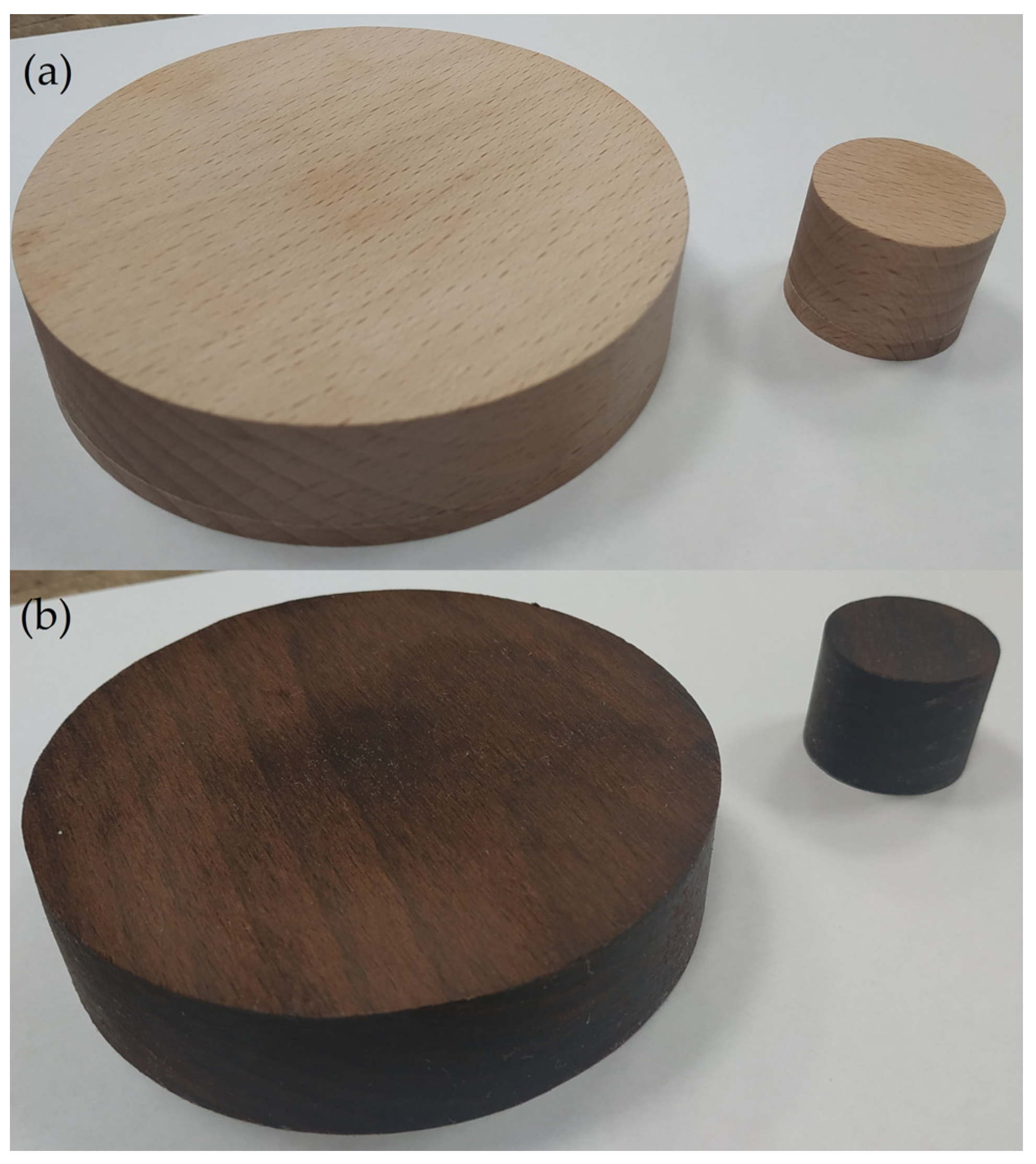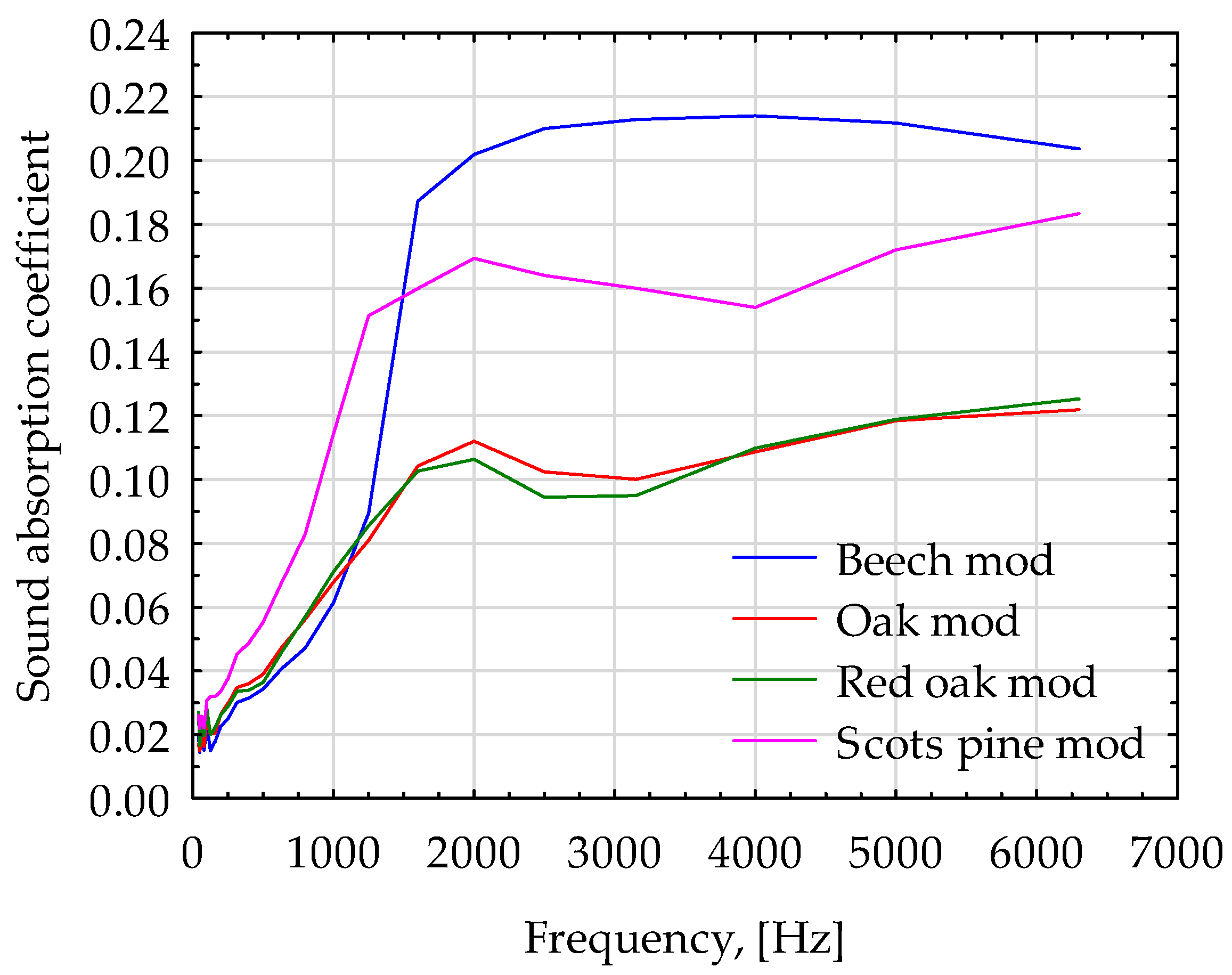Sound Wave Absorption Coefficient and Sound Velocity in Thermally Modified Wood
Abstract
:1. Introduction
2. Materials and Methods
3. Results and Discussion
4. Conclusions
Author Contributions
Funding
Institutional Review Board Statement
Informed Consent Statement
Data Availability Statement
Conflicts of Interest
References
- Hill, C.A. Wood Modification: Chemical, Thermal and Other Processes; John Wiley & Sons: Hoboken, NJ, USA, 2007. [Google Scholar]
- Boonstra, M.J.; Van Acker, J.; Tjeerdsma, B.F.; Kegel, E.V. Strength Properties of Thermally Modified Softwoods and Its Relation to Polymeric Structural Wood Constituents. Ann. For. Sci. 2007, 64, 679–690. [Google Scholar] [CrossRef] [Green Version]
- Viitaniemi, P.; Jamsa, S.; Ek, P.; Viitanen, H. Method for Improving Biodegradation Resistance and Dimensional Stability of Cellulosic Products. U.S. Patent US5678324A, 21 October 1997. [Google Scholar]
- Salmén, L.; Possler, H.; Stevanic, J.S.; Stanzl-Tschegg, S.E. Analysis of Thermally Treated Wood Samples Using Dynamic FT-IR-Spectroscopy; Walter de Gruyter: Berlin, Germany/New York, NY, USA, 2008; Volume 62, pp. 676–678. [Google Scholar] [CrossRef]
- Esteves, B.M.; Pereira, H.M. Wood Modification by Heat Treatment: A Review. BioResources 2008, 4, 370–404. [Google Scholar] [CrossRef]
- Zawadzki, J.; Radomski, A.; Gawron, J. The Effect of Thermal Modification on Selected Physical Properties of Wood of Scots Pine (Pinus sylvestris L.). Wood Res. 2013, 58, 243–250. [Google Scholar]
- Bettina, G.F.; Giambra, B.; Cavallaro, G.; Lazzara, G.; Megna, B.; Fakhrullin, R.; Akhatova, F.; Fakhrullin, R. Restoration of a XVII Century’s Predella Reliquary: From Physico-Chemical Characterization to the Conservation Process. Forests 2021, 12, 345. [Google Scholar] [CrossRef]
- Lisuzzo, L.; Hueckel, T.; Cavallaro, G.; Sacanna, S.; Lazzara, G. Pickering Emulsions Based on Wax and Halloysite Nanotubes: An Ecofriendly Protocol for the Treatment of Archeological Woods. ACS Appl. Mater. Interfaces 2021, 13, 1651–1661. [Google Scholar] [CrossRef] [PubMed]
- Chung, H.; Park, Y.; Yang, S.-Y.; Kim, H.; Han, Y.; Chang, Y.-S.; Yeo, H. Effect of Heat Treatment Temperature and Time on Sound Absorption Coefficient of Larix Kaempferi Wood. J. Wood Sci. 2017, 63, 575–579. [Google Scholar] [CrossRef]
- Adamczyk-Królak, I. Drewno Modyfikowane Termicznie. Constr. Optim. Energy Potential 2013, 1, 7–13. [Google Scholar]
- Mazela, B.; Zakrzewski, R.; Grześkowiak, W.; Cofta, G.; Bartkowiak, M. Resistance of Thermally Modified Wood to Basidiomycetes. Electron. J. Pol. Agric. Univ. 2004, 7, 1505-0297. [Google Scholar]
- Čermák, P.; Suchomelová, P.; Hess, D. Swelling Kinetics of Thermally Modified Wood. Eur. J. Wood Wood Prod. 2021, 79, 1337–1340. [Google Scholar] [CrossRef]
- Borůvka, V.; Zeidler, A.; Holeček, T. Comparison of Stiffness and Strength Properties of Untreated and Heat-Treated Wood of Douglas Fir and Alder. BioResources 2015, 10, 8281–8294. [Google Scholar] [CrossRef] [Green Version]
- Bekhta, P.; Niemz, P. Effect of High Temperature on the Change in Color, Dimensional Stability and Mechanical Properties of Spruce Wood; Walter de Gruyter: Berlin, Germany; New York, NY, USA, 2003. [Google Scholar]
- Bao, M.; Huang, X.; Jiang, M.; Yu, W.; Yu, Y. Effect of Thermo-Hydro-Mechanical Densification on Microstructure and Properties of Poplar Wood (Populus tomentosa). J. Wood Sci. 2017, 63, 591–605. [Google Scholar] [CrossRef]
- Smardzewski, J.; Batko, W.; Kamisiński, T.; Flach, A.; Pilch, A.; Dziurka, D.; Mirski, R.; Roszyk, E.; Majewski, A. Experimental Study of Wood Acoustic Absorption Characteristics. Holzforschung 2014, 68, 467–476. [Google Scholar] [CrossRef]
- Smardzewski, J.; Kamisiński, T. Właściwości Akustyczne Materiałów Stosowanych w Meblarstwie; Wydawnictwo Uniwersytetu Przyrodniczego: Wrocław, Poland, 2016. [Google Scholar]
- Mania, P.; Moliński, W.; Roszyk, E.; Górska, M. Optimization of Spruce (Picea abies L.) Wood Thermal Treatment Temperature to Improve Its Acoustic Properties. BioResources 2020, 15, 505–516. [Google Scholar] [CrossRef]
- Moliński, W.; Fabisiak, E.; Szwaba, T. Properties of Thermally Modified Ash Wood (Fraxinus americana) in the Aspect of Its Affinity to Water. Ann. Wars. Univ. Life Sci.-SGGW For. Wood Technol. 2010, 72, 27–31. [Google Scholar]
- Jang, E.-S. Experimental Investigation of the Sound Absorption Capability of Wood Pellets as an Eco-Friendly Material. J. Korean Wood Sci. Technol. 2022, 50, 126–133. [Google Scholar] [CrossRef]
- Xu, W.; Fang, X.; Han, J.; Wu, Z.; Zhang, J. Effect of Coating Thickness on Sound Absorption Property of Four Wood Species Commonly Used for Piano Soundboards. Wood Fiber Sci. 2020, 52, 28–43. [Google Scholar] [CrossRef] [Green Version]
- Kang, C.-W.; Jang, E.-S.; Lee, N.-H.; Jang, S.-S.; Lee, M. Air Permeability and Sound Absorption Coefficient Changes from Ultrasonic Treatment in a Cross Section of Malas (Homalium foetidum). J. Wood Sci. 2021, 67, 10. [Google Scholar] [CrossRef]
- Boubel, A.; Garoum, M.; Bousshine, S.; Bybi, A. Investigation of Loose Wood Chips and Sawdust as Alternative Sustainable Sound Absorber Materials. Appl. Acoust. 2021, 172, 107639. [Google Scholar] [CrossRef]
- Zhao, X.; Liu, Y.; Zhao, L.; Yazdkhasti, A.; Mao, Y.; Siciliano, A.P.; Dai, J.; Jing, S.; Xie, H.; Li, Z. A Scalable High-Porosity Wood for Sound Absorption and Thermal Insulation. Nat. Sustain. 2023, 6, 306–315. [Google Scholar] [CrossRef]
- Choe, H.; Sung, G.; Kim, J.H. Chemical Treatment of Wood Fibers to Enhance the Sound Absorption Coefficient of Flexible Polyurethane Composite Foams. Compos. Sci. Technol. 2018, 156, 19–27. [Google Scholar] [CrossRef]
- Kolya, H.; Kang, C.-W. Hygrothermal Treated Paulownia Hardwood Reveals Enhanced Sound Absorption Coefficient: An Effective and Facile Approach. Appl. Acoust. 2021, 174, 107758. [Google Scholar] [CrossRef]
- Wang, D.; Peng, L.; Zhu, G.; Fu, F.; Zhou, Y.; Song, B. Improving the Sound Absorption Capacity of Wood by Microwave Treatment. BioResources 2014, 9, 7504–7518. [Google Scholar] [CrossRef] [Green Version]
- Omran, T.A.; El-Sayed, A.B.; El-Shorbagy, K.A. Sound Absorption by Wood in Relation to Anatomical and Mechanical Properties. Appl. Acoust. 1980, 13, 449–456. [Google Scholar] [CrossRef]
- Wassilieff, C. Sound Absorption of Wood-Based Materials. Appl. Acoust. 1996, 48, 339–356. [Google Scholar] [CrossRef]
- González-Peña, M.M.; Hale, M.D.C. Colour in Thermally Modified Wood of Beech, Norway Spruce and Scots Pine. Part 2: Property Predictions from Colour Changes; Walter de Gruyter: Berlin, Germany; New York, NY, USA, 2009; Volume 63, pp. 394–401. [Google Scholar] [CrossRef]
- EN ISO 10534-2; Determination of Sound Absorption Coefficient and Acoustic Impedance with the Interferometer. ISO: Geneva, Switzerland, 2001.
- Bucur, V. Acoustics of Wood; Springer Series in Wood Science; Springer: Berlin/Heidelberg, Germany, 2006; ISBN 978-3-540-26123-0. [Google Scholar]
- Wagenführ, R. Holzatlas; Fachbuchverlag Leipzig: Leipzig, Germany, 2000; ISBN 978-3-446-21390-6. [Google Scholar]
- Helbin, J. Środowiskowe Czynniki Fizyczne Wpływające na Organizm Człowieka; Wydawnictwo Uniwersytetu Jagiellońskiego: Kraków, Poland, 2008; ISBN 978-83-233-2467-6. [Google Scholar]
- Kang, C.; Kang, W.; Chung, W.; Matsumura, J.; Oda, K. Changes in Anatomical Features, Air Permeability and Sound Absorption Capability of Wood Induced by Delignification Treatment. J. Fac. Agric. Kyushu Univ. 2008, 53, 479–483. [Google Scholar] [CrossRef]







| Wood Species | Oven Dry | ||
|---|---|---|---|
| (kg·m−3) | (%) | ||
| Beech | 743 ± 32.6 | 579 ± 38.0 | −22.1 ± 1.02 |
| Oak | 686 ± 41.5 | 573 ± 46.1 | −16.5 ± 0.94 |
| Red oak | 679 ± 49.1 | 601 ± 50.7 | −11.5 ± 0.92 |
| Scots pine | 641 ± 43.5 | 564 ± 38.3 | −12.0 ± 0.98 |
| Wood Species | 29 mm | 100 mm | Average | ||||||
|---|---|---|---|---|---|---|---|---|---|
| VRR | VLL | VTT | VRR | VLL | VTT | VRR | VLL | VTT | |
| [m/s] | |||||||||
| Beech | 2439 | 5331 | 1457 | 2274 | 4831 | 1354 | 2356 | 5081 | 1405 |
| Oak | 2203 | 5458 | 1219 | 2115 | 5178 | 1355 | 2159 | 5318 | 1287 |
| Red oak | 2516 | 5247 | 1228 | 2025 | 4257 | 1268 | 2271 | 4752 | 1248 |
| Scots pine | 1865 | 6094 | 901 | 2172 | 6430 | 1060 | 2019 | 6262 | 981 |
| Wood Species | 29 mm | 100 mm | Average | ||||||
|---|---|---|---|---|---|---|---|---|---|
| VRR | VLL | VTT | VRR | VLL | VTT | VRR | VLL | VTT | |
| [m/s] | |||||||||
| Beech | 1951 | 5365 | 1066 | 1522 | 5708 | 1302 | 1737 | 5536 | 1184 |
| Oak | 2368 | 5283 | 1149 | 2345 | 5206 | 1321 | 2230 | 5244 | 1235 |
| Red oak | 2650 | 5455 | 1044 | 2230 | 5629 | 1266 | 2440 | 5542 | 1155 |
| Scots pine | 1820 | 6364 | 885 | 2062 | 6495 | 811 | 1991 | 6430 | 848 |
| Wood Species | Oven Dry | ||
|---|---|---|---|
| (MPa) | (%) | ||
| Beech | 19,182 ± 1922 | 17,745 ± 2089 | −7.5 ± 0.42 |
| Oak | 19,401 ± 1935 | 15,757 ± 2416 | −18.8 ± 0.68 |
| Red oak | 15,333 ± 1757 | 18,459 ± 2332 | +20.4 ± 1.72 |
| Scots pine | 25,135 ± 2134 | 23,318 ± 2688 | −7.2 ± 0.21 |
Disclaimer/Publisher’s Note: The statements, opinions and data contained in all publications are solely those of the individual author(s) and contributor(s) and not of MDPI and/or the editor(s). MDPI and/or the editor(s) disclaim responsibility for any injury to people or property resulting from any ideas, methods, instructions or products referred to in the content. |
© 2023 by the authors. Licensee MDPI, Basel, Switzerland. This article is an open access article distributed under the terms and conditions of the Creative Commons Attribution (CC BY) license (https://creativecommons.org/licenses/by/4.0/).
Share and Cite
Mania, P.; Flach, A.; Pilarska, M. Sound Wave Absorption Coefficient and Sound Velocity in Thermally Modified Wood. Appl. Sci. 2023, 13, 8136. https://doi.org/10.3390/app13148136
Mania P, Flach A, Pilarska M. Sound Wave Absorption Coefficient and Sound Velocity in Thermally Modified Wood. Applied Sciences. 2023; 13(14):8136. https://doi.org/10.3390/app13148136
Chicago/Turabian StyleMania, Przemysław, Artur Flach, and Marta Pilarska. 2023. "Sound Wave Absorption Coefficient and Sound Velocity in Thermally Modified Wood" Applied Sciences 13, no. 14: 8136. https://doi.org/10.3390/app13148136
APA StyleMania, P., Flach, A., & Pilarska, M. (2023). Sound Wave Absorption Coefficient and Sound Velocity in Thermally Modified Wood. Applied Sciences, 13(14), 8136. https://doi.org/10.3390/app13148136








